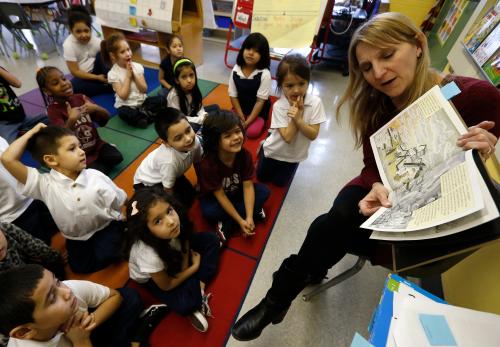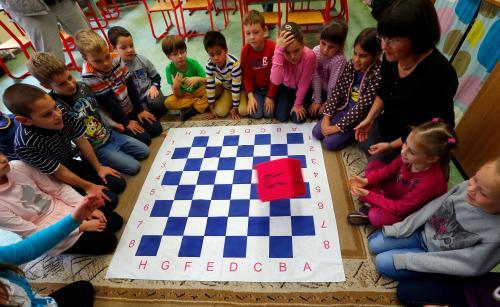In primary school, we were both lucky to have teachers who thought we were brilliant: Ms. Darrow believed Sameer was an excellent student despite average grades, and Ms. Lewis made Niharika feel like she could survive anything. Looking back, neither of us knows why they thought this way, but we’re certain that they both truly felt this way, and their feelings made us believe it as well. Our time with these teachers made us believe in our ability to take on academic challenges, building a base of confidence that we would draw on throughout our lives.
We experienced firsthand that what a teacher expects from a student can have a powerful effect. But we also know that there are many students who never have a teacher who believes in them. There is a strong perception among teachers and other stakeholders that students from disadvantaged economic and social backgrounds cannot learn as well. These beliefs adversely impact what teachers do in the classroom and in turn how much students learn and grow. It’s precisely these students from disadvantaged backgrounds who have been hit hardest by COVID-19 and who need the most help. To bridge this growing inequality in learning, we must design support for teachers to nurture the belief that all students can learn.
The problem: The belief that all students can learn is not universal
We recently surveyed school leaders and teachers from India, Kenya, Malaysia, and Indonesia and found that only 48 percent of teachers in our sample believed that all students can learn, regardless of familial background or educational experience. This confirms a comprehensive World Bank survey of 16,000 teachers from eight low- and middle-income Latin American, African, and Asian countries, which found that a substantial portion of teachers believe they can’t help students who start out below grade level or come from troubled homes (Figure 1).
Figure 1. Teacher beliefs on their students’ learning abilities
 Source: World Bank, 2018.
Source: World Bank, 2018.
Teachers underestimate the abilities of their students because of social attitudes and community prejudices. In low-income countries, the high social gap between teachers and students may reduce teacher empathy and motivation to work with their students.
Further, because school leaders and government officials rarely track teaching practices and student progress, teachers don’t internalize their responsibility toward ensuring all students are learning.
All of the above coupled with persistently low levels of prior student performance may reinforce teacher beliefs that not all students can learn.
Why the problem matters: There is a vicious cycle of low expectations
What teachers expect students to learn influences outcomes for their students. In a famous psychology experiment from 65 years ago, Rosenthal and Jacobsen (1968) falsely told teachers that selected students were identified by a test to be “late bloomers” and would learn great amounts over the course of the years when in fact the researchers had selected students at random. A year later, the students identified as “late bloomers” had learned more than their peers because the teachers increased their support to these students.
Since this experiment, many other psychology studies have been done to replicate and understand the impact of teacher expectations on student achievement. In a landmark review of more than 30 years of research, Jussim and Harber (2005) find that while the original study may be overstating its results, teacher expectations do impact students, and this can be particularly strong for students from stigmatized groups. Rubie-Davies and colleagues (2006) found that teacher expectations of Maori students in New Zealand were lower than their peers, and can lead to lower outcomes. Recent research in economics to understand school effectiveness (here and here) in the United States find that schools that develop a culture that assumes all students can learn at high levels are best at raising the achievement of students from marginalized backgrounds.
Teacher expectations create a reinforcing cycle. Teacher beliefs about students’ growth potential shape those teachers’ actions, which then, in turn, impacts students’ growth, feeding back into teachers’ beliefs about students. In low- and middle-income countries, decades of underperformance of school systems have created a deeply ingrained belief that not all students can learn, which continues to limit the potential of these school systems to improve what they deliver to students (Figure 2).
Figure 2. The reinforcing cycle of teachers’ beliefs on student outcomes
How we can address the problem: Shift teacher expectations and behavior
Behavioral science has taught us that we must understand the mental models of key actors in a system to shift its outcomes. Sectors like health have extensively relied on learnings from behavioral science to improve health outcomes. In education, we must similarly research, develop, and test behavioral approaches to improving teacher performance. We suggest three broad categories of interventions for school systems to explore.
1. Develop leaders that build a culture of high expectations in the system
In a Global School Leader survey, we find that in schools where leaders do believe that students can learn, 54 percent of teachers also share this belief, compared with 37 percent of teachers that hold high expectations when the school leader does not. This reinforces studies that suggest that school leaders can increase teacher responsibility for student learning through organizational structures and discourse that help challenge existing beliefs. School systems should invest in understanding how they can grow and empower leaders to create an environment where the primary focus is on improving learning outcomes.
2. Explicitly discuss the power of teacher expectations
Pre-service and in-service teacher training must address the power of teacher expectations directly. Teachers can be supported to develop a growth mindset so that they view the problem of low student-learning levels as something they can change. Highlighting positive case studies that illustrate challenges that teachers and students face on a regular basis and ways they can overcome them can encourage teachers to reflect on the link between their classroom practices and the impact on students. Experiential training models can help teachers experience firsthand how their empathy for and expectations of students can drive learning.
3. Improving practices can shift beliefs
Beliefs can be deep rooted and hard to shift, but when teachers succeed in the classroom, that can also shift their beliefs on what students can achieve. Encouraging teachers to adopt classroom tools and effective pedagogical practices could help improve students’ learning levels, which could, in turn, shift teachers’ beliefs on student abilities.
Ensuring that all students have teachers like Ms. Darrow and Ms. Lewis with high expectations for their students’ success will require a totally fresh perception of students’ intelligence and ability. Until current practices address teacher expectations head-on and shift the “soft bigotry of low expectations” into the tangible empowerment of high expectations, students won’t reach their full growth potential.







Commentary
How teacher expectations empower student learning
July 29, 2021